_________________________________
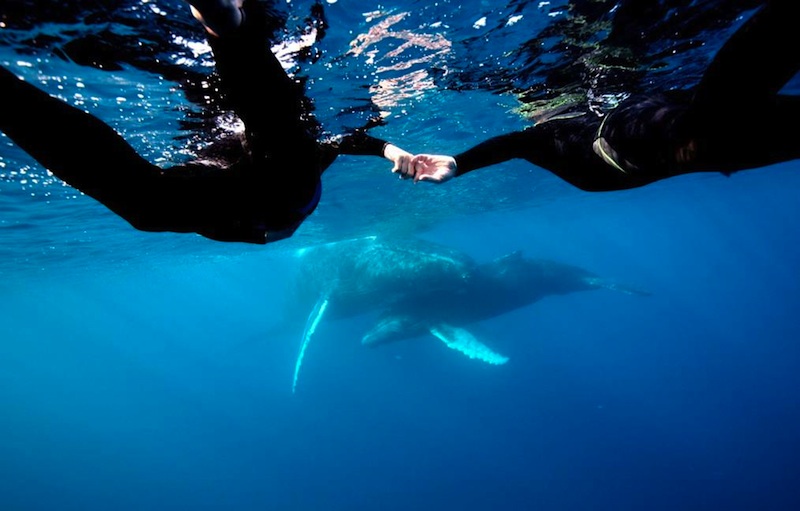
STORIES & PICTURES OF
WHALES OF THE CARIBBEAN, 2013
2014 DOMINICAN REPUBLIC
2015 Dominican Republic
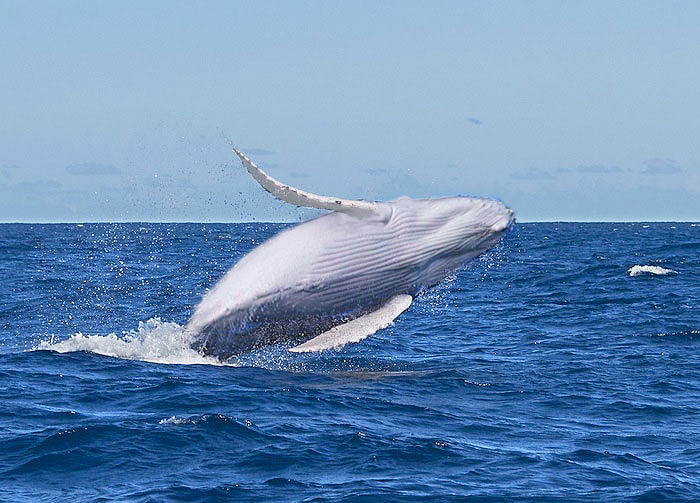

_________________________________
A WHITE WHALE AT BIRTH
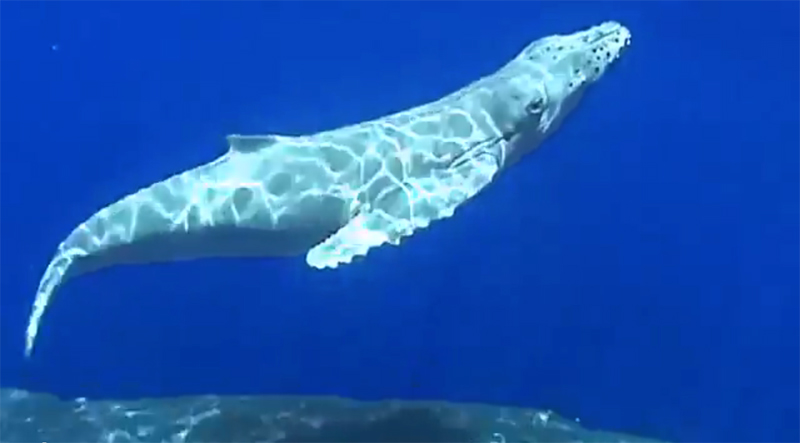
TURNS DARK VERY SOON AFTER...

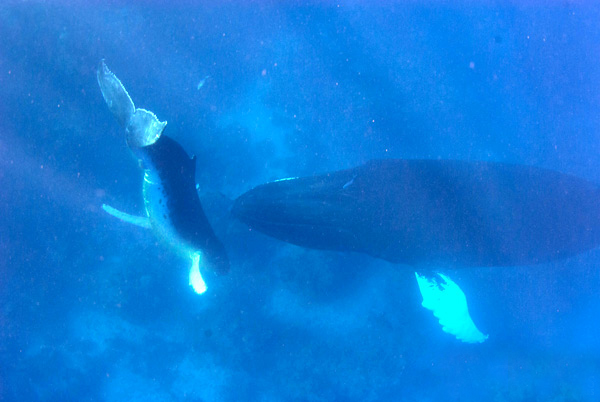
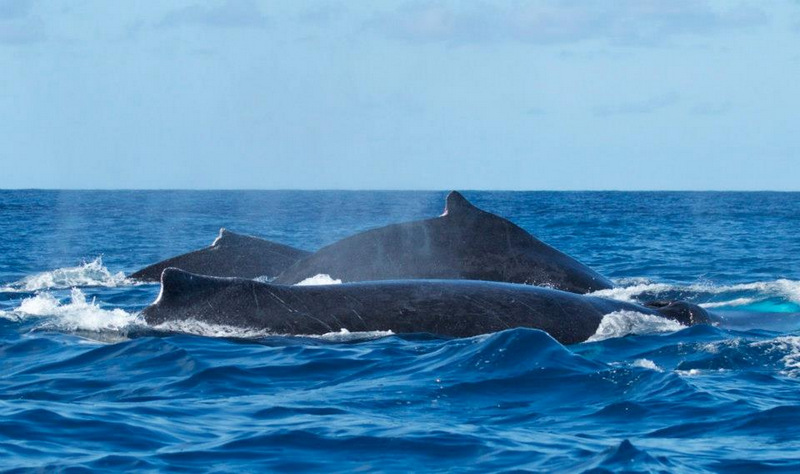
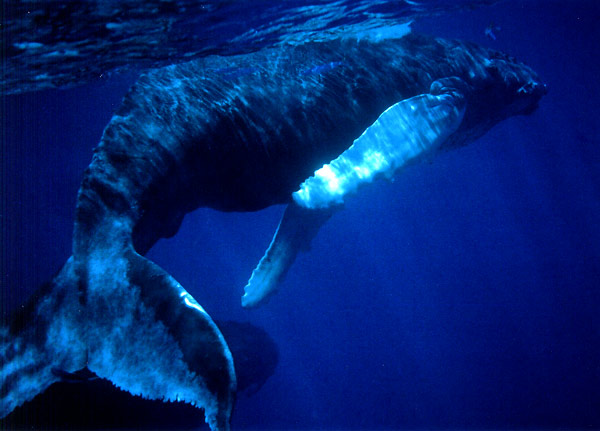 ©Lisa
Denning
©Lisa
Denning
![]()
This is a story about my relationship with
the fifth largest of the great whales, the mysterious and gentle
Humpback Whales.
Let yourself go deeper and deeper with these sensitive whales, into endless expanses of blue, into the unknown. Open yourself to their communication, setting aside your use of voice and remembering our first mode of contact: VIBRATION. Let their sounds — far beyond your ability to hear — enter your awareness. What can we learn from the whales? What
are their dreams and their feelings — their experiences with
the mind-expanding effects of diving deeply into ocean environments
and multiple octaves of sound? Who do they meet, fathoms deep
in the ocean? What do they see and know? Are we listening?
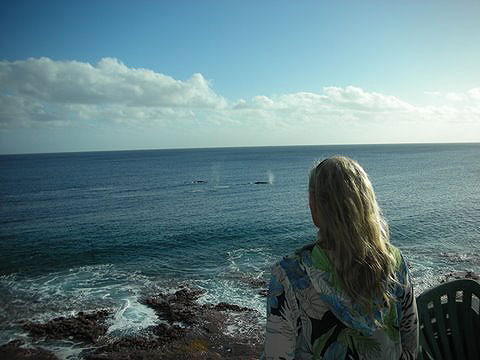
I feel the bubbles of air and water caressing
your skin, I feel the ease….. and grace…… of the
dive…… deep into the liquid environment In my dreams I meet the whales who are the molecular librarians of the Earth's evolution. What we call the "Akashic Record" is living in the oceans of planet Earth, contained in the water molecules, where information is stored. Since water is never destroyed, only recycled, all of Earth's history remains safe in these ocean archives. The whales can access the information, circulate it and contribute to it — communicating by contacting the intelligence in the water molecules which enter matter and travel through it.
Join us with the gentle Humpback whales in Hawaii and the Caribbean.
Humpback Whales Interacting |

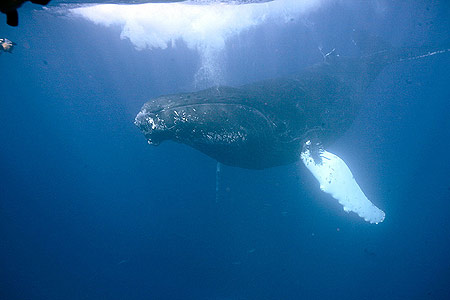
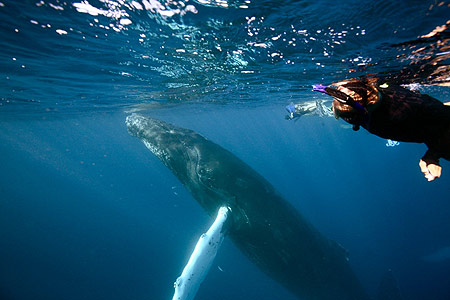
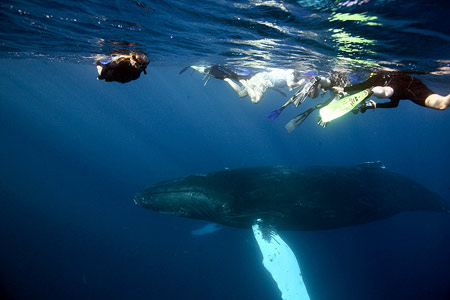
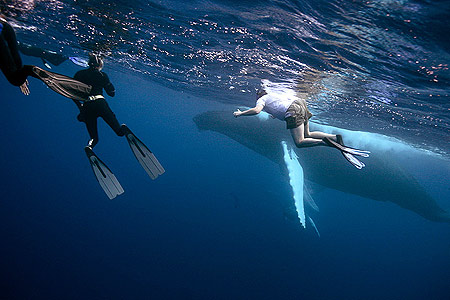
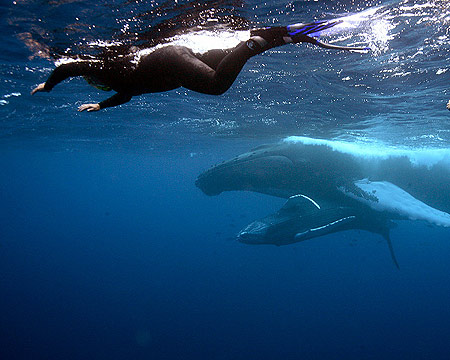
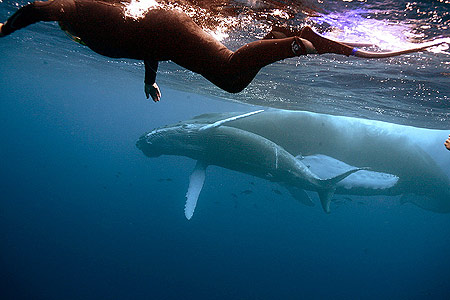
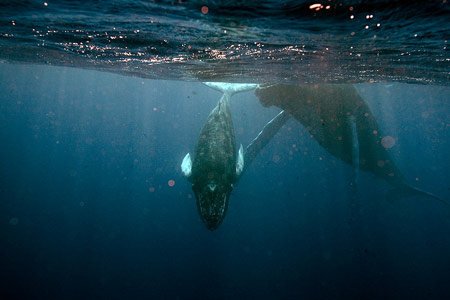
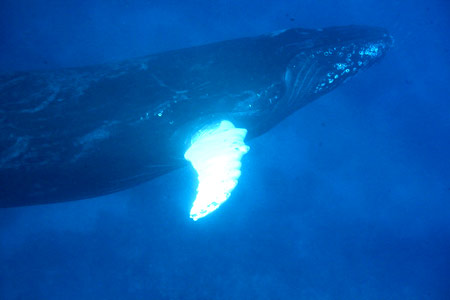
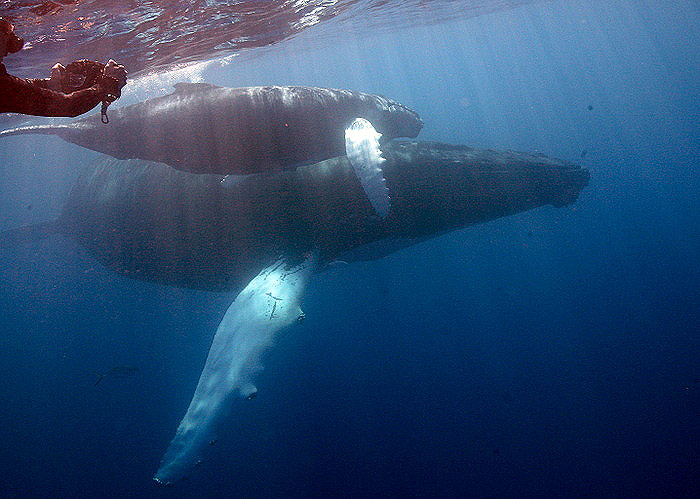
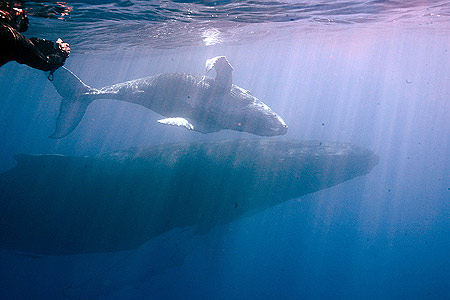
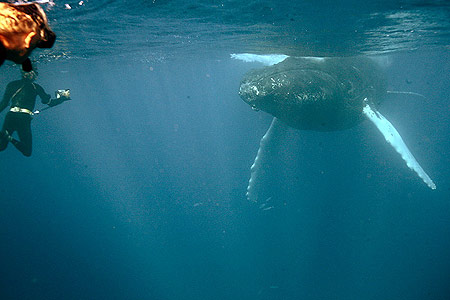
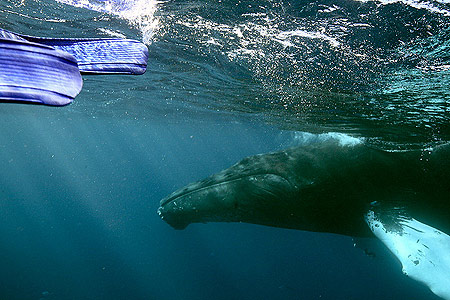


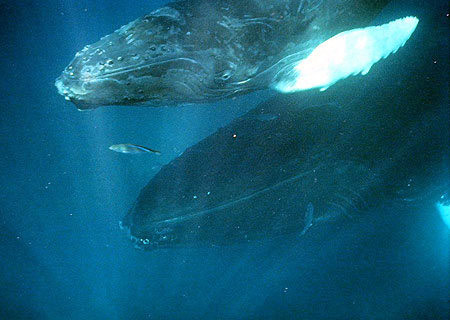

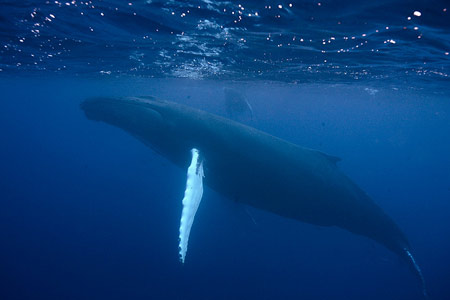
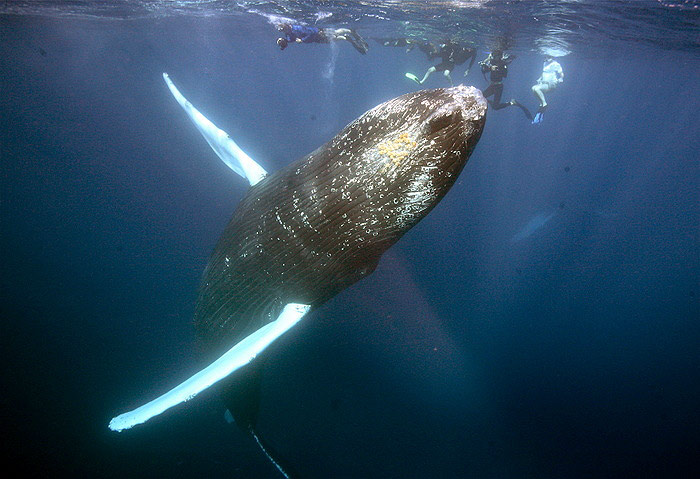
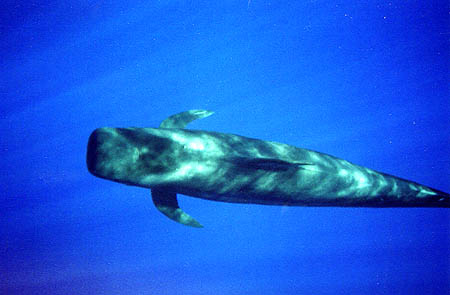
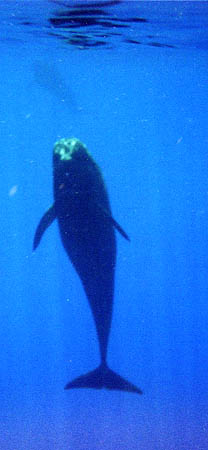
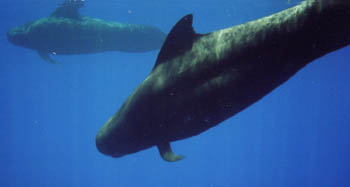
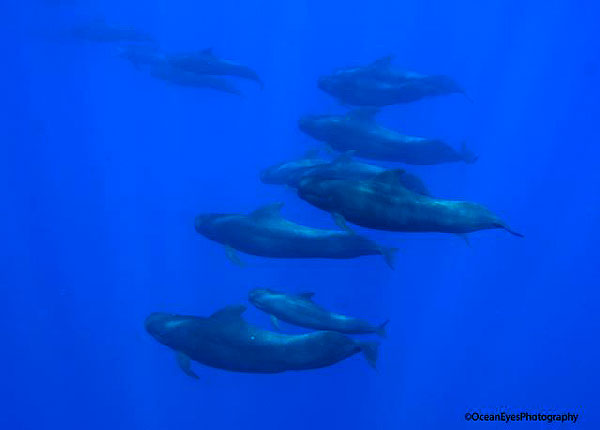


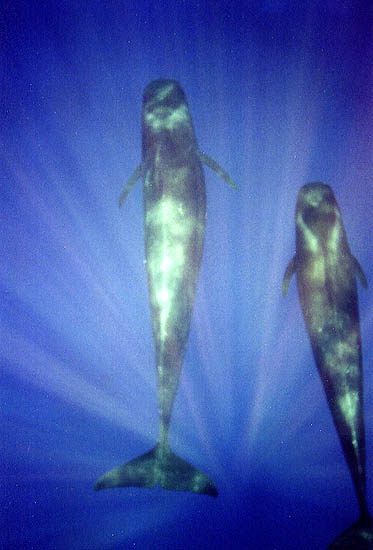
|
![]()
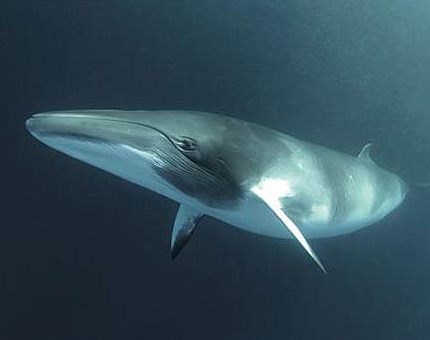
Antarctic Minke whale
|
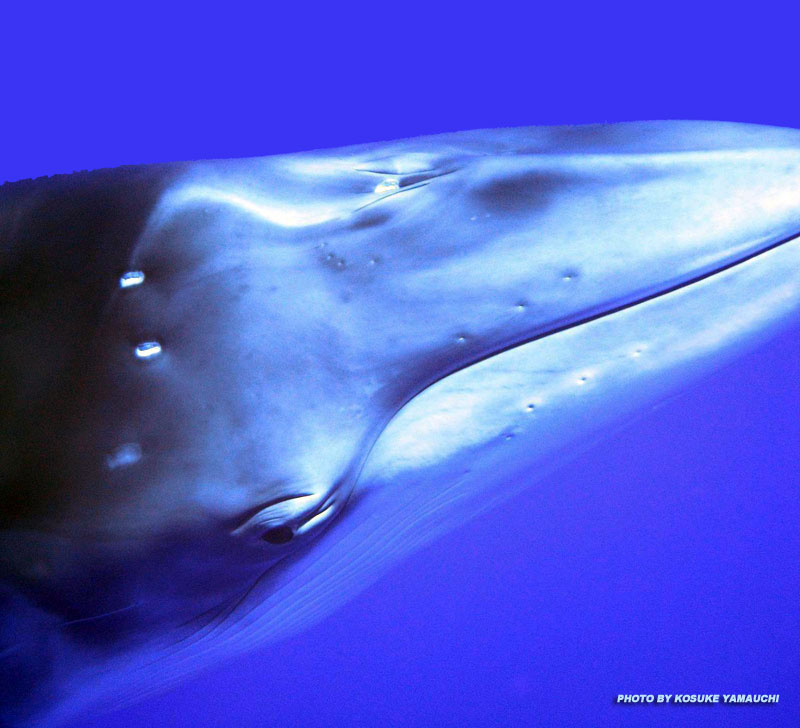
|
![]()
Bryde's (pronounced "broodus") whalesWe swam with two of them in the waters of Rurutu Island in the South Pacific (September, 2011) They are usually found as solitary animals, or in small groups of 2 to 3. Bryde's whales are most common in tropical and sub-tropical waters. No one knows where breeding takes place.Bryde’s whales are named after the man who first documented them, Mr.Bryde. They are rorquals -- whales with a dorsal fin and long throat grooves on the lower side of their bodies. They are slim and streamlined. The Bryde’s whales have three ridges running from the tip of the head to the blowholes, and 40 to 50 throat grooves. (baleen)They have a bluish-gray body with white on the underside. Some of them have dark gray or almost white scars that may be caused by bites of fish that attach themselves to the skin and bore into the flesh.
The pectoral fins are relatively short and pointed at the tips. The dorsal fin is located about one-third of the body length forward of the notch in the tail. The tails are also relatively small in relation to body size.The Bryde's whale is 40 to 50 feet long. Females are slightly larger than males.Bryde's and Minke and Humpback are baleen whales having a series of fringed, overlapping plates that hang from the upper jaw inside the mouth where teeth would be. The plates are composed of a fingernail-like material called keratin that frays out into fine hairs on the ends. Bryde's whales have 250 to 350 baleen plates on each side, which are 16 inches long. They are usually fish eaters, often feeding on schools of anchovies, sardines, herring, or mackerel. While feeding, the Bryde's whale displays a more regular up-and-down pattern, frequently arching its back quite high and diving for 5 to 15 minutes.
The marine specialists in Rurutu were very excited to photograph these whales since they had not seen them here before.
|
![]()
Pygmy Killer Whales
©2001, Lisa Denning
These little whales are seen on rare occasions
along the Kona coast. The adult Pygmy Killer whales are between
7 to 9 feet in length and weigh approximately 200-400 pounds.
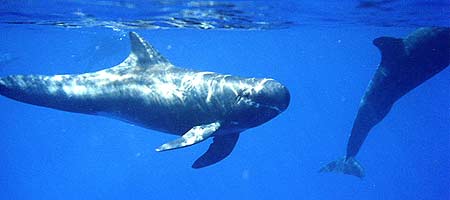 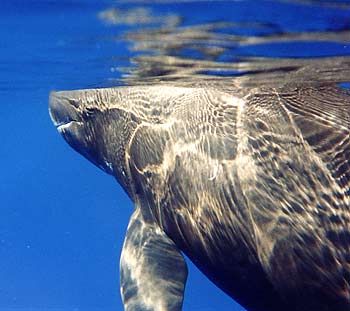
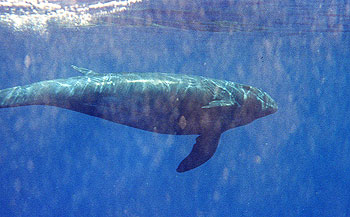 
False Killer whales are being seen regularly now along the Kona coast. In 2001, they returned to our local waters after a ten-year absence. They travel in groups of 25 to 100 and are often seen moving fast. When these energetic and playful whales are traveling, they lift their heads and most of their bodies out of the water, leaping and breaching as they go. Often riding bow waves of boats … they act like overgrown dolphins! Their color is a glossy black and the adults are 14 - 20 feet in length, weighing 2000 to 3000 pounds. They have been observed carrying large pieces of tuna fish in their mouth, swimming directly to snorkelers and dropping the fish in the water near them. When they notice the swimmer is not eating the food, they quickly take the piece of fish back and swim off with it. (read: Dolphins into the Future, page 97) They are known for generously sharing their food. Recently one False Killer whale was observed bringing a large chunk of fish to other whales in his herd and giving it to them to eat as he circled nearby. The families remain together in pods, sharing and caring for each other. The bump or elbow on the leading edge of the whales' flippers is an identifying characteristic of this species.
In Hawaii, our friends the fisherman often contact our boats to report their sightings of whales. On occasion the report is a sighting of 10 - 15 Orca whales, swimming twenty miles off shore. These "Hawaiian" Orcas swim from the Arctic to Antarctic and between Asia and America. I first met them at West Craycroft Island in the northern Pacific region.
The Orcas were among the first whales I met, elegant and dramatic-looking with their tall black dorsal fins and beautiful white markings. I hold them lovingly in my heart.
I photographed this Beaked whale as she
approached our boat one day when we were 3 miles from shore. She
was alone and with our engine shut down, she chose to stay alongside
our boat for a half hour before we departed. When we entered the
water to snorkel, she approached us and remained with us. If I
could put a human feeling onto this whale, I would say she seemed
lonely and seeking out our company. I have extensive video footage
of this uncommon cetacean.
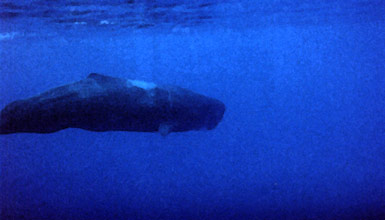 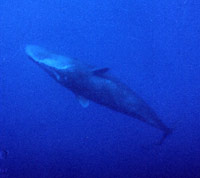
©Jean-Luc Bozzoli I first met the Sperm Whales (also called Cachalot Whales) in the Sea of Cortez, Mexico, where they share the water with many species of dolphins and whales, including, Fin whales, Gray whales and Blue whales. Here in Hawaii, the Sperm whales are usually seen in small groups 15 miles or more from the Big Island shores. In general, these whales prefer to live in deep waters. Diving deeply, they often remain underwater for more than an hour. Recent research using hydrophones to detect the whales' echolocation clicking indicates these whales can dive 10,000 feet or more. At these depths, their lungs collapse, their heartbeat slows down and they rely on the oxygen stored in their muscles and blood to supply their heart and brain. On the surface, they breathe repeatedly for ten to fifteen minutes, before diving again. Their blowhole on the extreme left side of the top of their head can identify Sperm whales. They have a box-shaped head, small flippers and rippled skin. They have the largest brains on our planet. These brains are used for navigation and communication. In addition they have many other capabilities that function beyond anything we can as yet comprehend.
The females are pregnant for 17 months, and nurse the babies for a year or more. The reproductive cycle is about four years. Often the mothers and babies swim in a group as a nursery pod, while the young males make up another pod. Older males may swim alone. Females who are ready to mate may have a male accompanying their pod. These whales can be very playful, breaching and chasing each other, although most of their time is spent many fathoms deep.
The mighty Sperm whales (aka Cachalot) with the largest brains on the planet, live in Hawaiian waters year round. In April we met a very special young, female, Sperm Whale. As we were swimming in the deep blue waters, where the bottom of the ocean is miles away, this young Sperm whale came to visit. With her huge dark head and jaws, small eyes, about 35 feet long, she seemed to be alone (although who really knows what is below in the blue black waters).
The presence of a Sperm whale surrounds you with a feeling of great peace. And so we became suddenly silent and respectful. After a number of loud and powerful blows, she slowly arched her massive body and dove down. With our thoughts, we said Thank you and Goodbye as we watched her disappear.
She did this repeatedly, surfacing and then slowly diving and quickly returning. We felt she was playing with us and enjoying our company. Perhaps she could sonar us best from down below, getting to know us, trust us. Maybe she thought we might follow her into the deep. We enjoyed this unique encounter and this inter-species friendship. Anyone who has ever met a Sperm whale in the wild knows, they can swim extremely fast and dive thousands of feet whenever they choose. She stayed in the ocean with us for over an hour.
This is part of the Beauty and Mystery of living and swimming within the waters of the blue Pacific. I hope you will join us here. With Love,
This may be the most beautiful whale of all! She is sleek and streamlined with few scars and protuberances. The Fin whale is the second largest whale on Earth, reaching lengths of over 80 feet… her cousin, the Blue whale being the largest. The newborn Fin whales are approximately 20 feet in length, born after a gestation period of eleven to twelve months. Sometimes called "Finbacks" the Fin whales migrate in groups, with individual whales a mile or more apart, yet still part of the same group. Their language is acoustic and they easily communicate over a range of 20 to 30 miles. Although they are seen within 200 miles of Hawaii, I photographed this one in the Sea of Cortez.
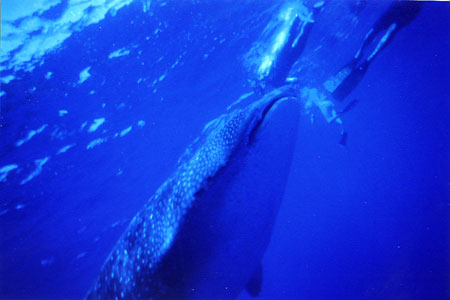
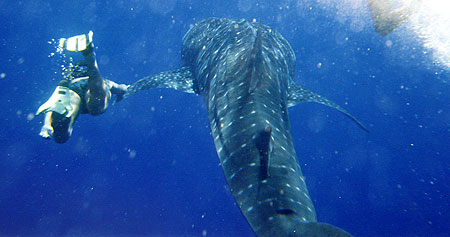 
 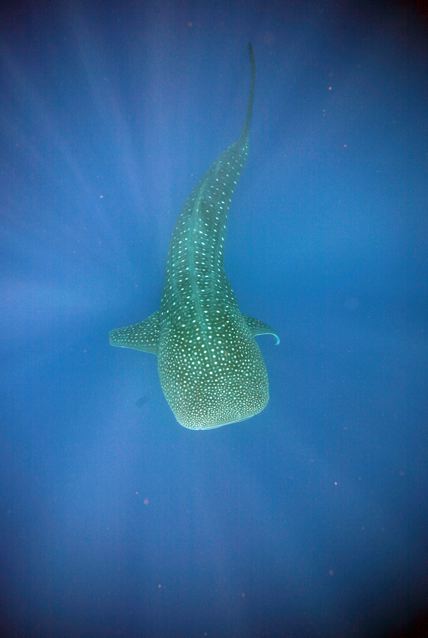 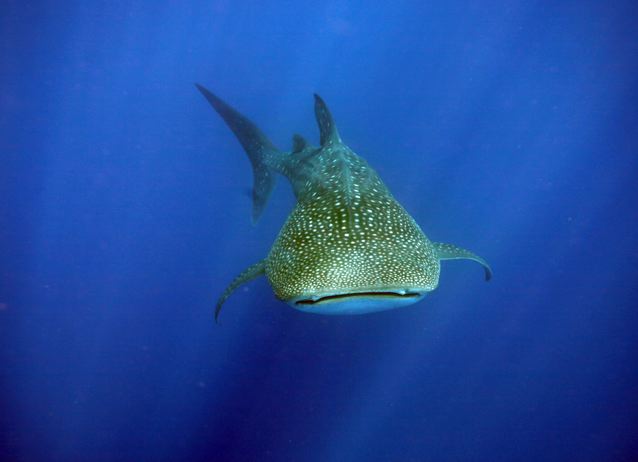 ©Lisa Denning (all rights reserved)
|
![]()